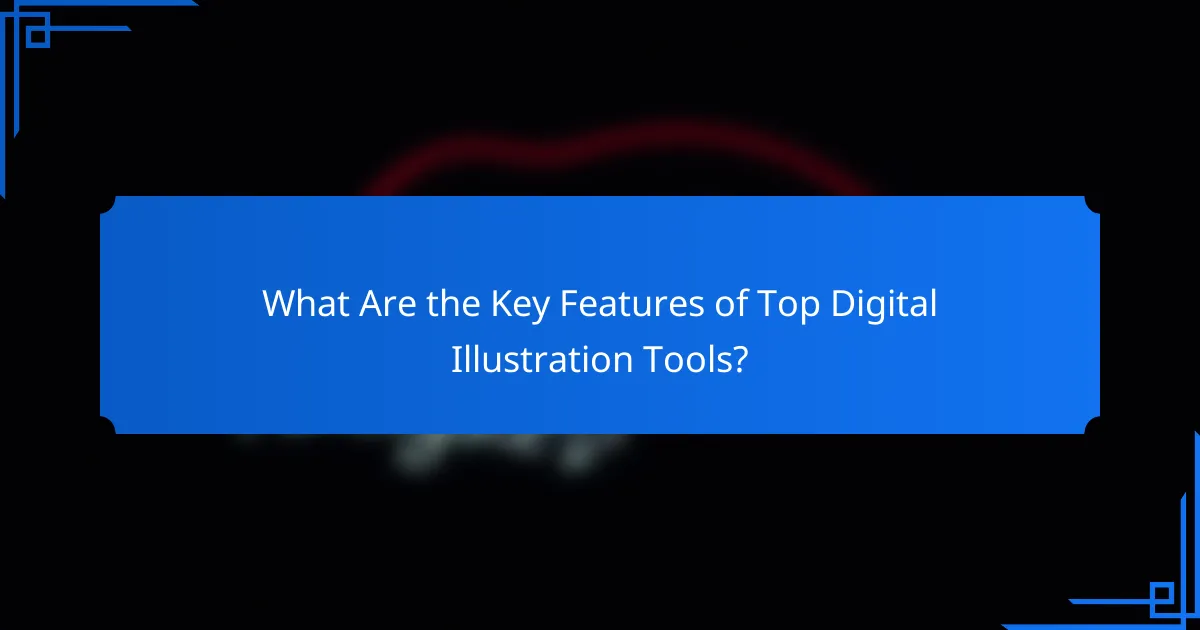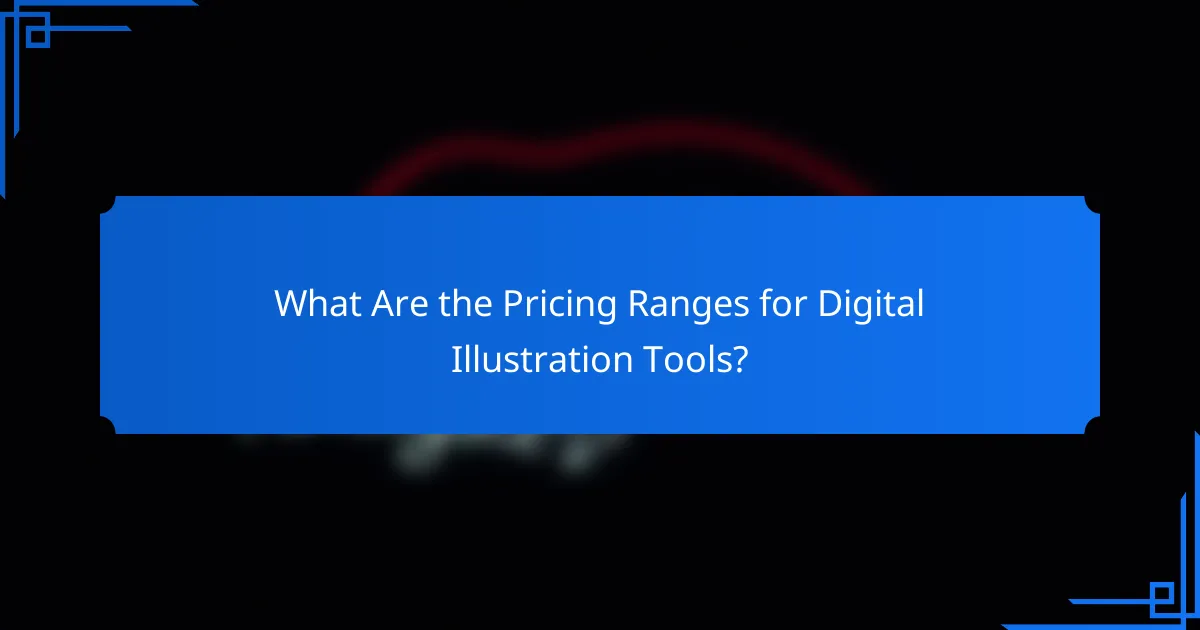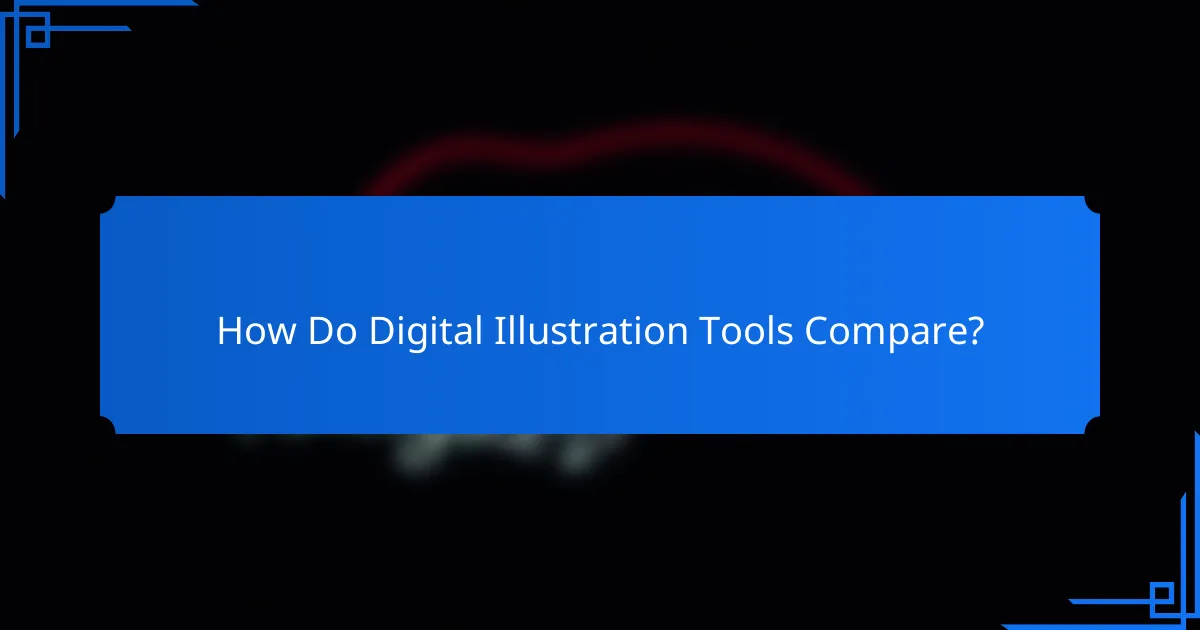In the ever-evolving world of digital design, having the right illustration tools is crucial for both creativity and productivity. The best tools offer a blend of versatility, user-friendliness, and powerful features, catering to a wide range of styles and workflows. By understanding your specific needs and preferences, you can select the ideal tools that will elevate your design projects to new heights.

What Are the Best Digital Illustration Tools for Designers?
The best digital illustration tools for designers combine versatility, ease of use, and powerful features. These tools cater to various styles and workflows, making them essential for both beginners and professionals in the design industry.
Adobe Illustrator
Adobe Illustrator is a leading vector graphics software widely used by designers for creating illustrations, logos, and complex graphics. Its robust set of tools allows for precise control over shapes, colors, and typography, making it ideal for both print and digital media.
When using Illustrator, take advantage of features like the Pen Tool for custom shapes and the Artboards for multiple designs within a single project. Consider subscribing to Adobe Creative Cloud for regular updates and access to additional resources.
CorelDRAW
CorelDRAW is another powerful vector graphic design software known for its user-friendly interface and extensive toolset. It is particularly favored for its strong typography capabilities and layout features, making it suitable for both graphic design and illustration.
CorelDRAW offers unique features like the LiveSketch tool, which allows for natural drawing with a stylus. Users should explore the various brushes and effects available to enhance their illustrations and streamline their workflow.
Procreate
Procreate is a popular digital illustration app designed specifically for the iPad, favored by many artists for its intuitive touch interface and extensive brush library. It is particularly useful for creating detailed illustrations and concept art on the go.
Procreate supports high-resolution canvases and offers features like layering and blending modes, which are essential for professional-quality artwork. Artists should utilize the app’s customization options to create unique brushes tailored to their style.
Affinity Designer
Affinity Designer is a cost-effective alternative to Adobe Illustrator, offering a similar range of vector and raster design tools. It is known for its smooth performance and one-time purchase model, making it accessible for freelancers and small businesses.
With features like real-time performance and a variety of export options, Affinity Designer is suitable for both web and print design. Users should take advantage of the software’s extensive tutorials to maximize their proficiency and creativity.
Clip Studio Paint
Clip Studio Paint is a versatile illustration software that excels in digital painting and comic creation. It provides a wide array of brushes and tools tailored for artists, making it a favorite among illustrators and animators.
This software supports both raster and vector layers, allowing for flexibility in artwork creation. Users should explore the software’s animation features and 3D models to enhance their illustrations and storytelling capabilities.

How to Choose the Right Digital Illustration Tool?
Choosing the right digital illustration tool depends on your specific design needs, style, and workflow. Consider factors such as compatibility with your devices, pricing structures, and the features that best support your creative process.
Consider your design style
Your design style plays a crucial role in selecting a digital illustration tool. For instance, if you prefer vector graphics, tools like Adobe Illustrator or CorelDRAW may be ideal. Alternatively, if you lean towards raster graphics, software like Adobe Photoshop or Procreate could better suit your needs.
Think about the types of projects you typically undertake. If you often create detailed illustrations or animations, look for tools that offer robust features like layering, advanced brushes, and customizable palettes.
Evaluate compatibility with devices
Device compatibility is essential when choosing a digital illustration tool. Ensure that the software you select works seamlessly with your operating system, whether it’s Windows, macOS, or a mobile platform. Some tools are designed specifically for tablets, like Procreate for iPad, while others are more versatile across devices.
Check if the tool supports cloud functionality, which allows you to access your work from multiple devices. This can enhance your workflow, especially if you switch between a desktop and a tablet frequently.
Assess pricing and subscription models
Pricing and subscription models vary widely among digital illustration tools. Some software, like GIMP, is free and open-source, while others, such as Adobe Creative Cloud, operate on a subscription basis that can range from low monthly fees to higher annual costs. Consider your budget and how much you are willing to invest in your tools.
Look for trial versions or free tiers to test the software before committing. This allows you to evaluate whether the tool meets your needs without financial risk. Be mindful of any additional costs for updates or premium features that may arise later on.

What Are the Key Features of Top Digital Illustration Tools?
Top digital illustration tools typically feature vector and raster capabilities, user-friendly interfaces, and collaboration options. These elements enhance the design process, allowing professionals to create high-quality illustrations efficiently.
Vector vs. raster capabilities
Vector capabilities allow designers to create scalable graphics without losing quality, making them ideal for logos and illustrations that require resizing. Raster capabilities, on the other hand, are better suited for detailed images like photographs, but they can lose clarity when scaled. Understanding the strengths of each type is crucial for selecting the right tool for specific projects.
Many professional tools offer a combination of both vector and raster functionalities, enabling flexibility in design. For instance, Adobe Illustrator excels in vector graphics, while Adobe Photoshop is renowned for its raster capabilities. Consider your project needs when choosing between these options.
User interface and ease of use
A user-friendly interface is essential for enhancing productivity in digital illustration tools. Intuitive layouts and customizable workspaces can significantly reduce the learning curve, allowing designers to focus on creativity rather than navigation. Tools like Procreate and Affinity Designer are praised for their accessible interfaces.
When selecting a tool, consider how easily you can access essential features and tools. Look for options that allow for keyboard shortcuts and customizable menus to streamline your workflow. Avoid tools that are overly complex if you are just starting, as this can hinder your creative process.
Collaboration features
Collaboration features are increasingly important in digital illustration, especially for teams working remotely. Tools that support real-time editing, commenting, and sharing can enhance teamwork and improve project outcomes. Software like Figma and Adobe XD offers robust collaboration capabilities that facilitate seamless communication among team members.
When evaluating collaboration tools, check for version control and file sharing options. Ensure that the tool allows easy export in various formats to accommodate different stakeholders’ needs. Avoid tools that lack these features, as they can lead to miscommunication and project delays.

What Are the Pricing Ranges for Digital Illustration Tools?
The pricing for digital illustration tools varies significantly based on features, subscription models, and user needs. Generally, you can expect to pay anywhere from a few dollars per month for basic apps to several hundred dollars for comprehensive software packages.
Adobe Illustrator pricing
Adobe Illustrator typically operates on a subscription model, with plans starting around $20 to $30 per month for individual users. Annual subscriptions may offer slight discounts, bringing the cost down to approximately $240 to $300 per year.
For teams, pricing can increase significantly, often ranging from $30 to $50 per user per month, depending on the number of licenses and additional features included. Consider the need for collaboration tools when evaluating costs.
CorelDRAW pricing
CorelDRAW offers both a one-time purchase option and a subscription model. The one-time purchase price is usually around $500, while the subscription can range from $20 to $25 per month, or about $200 to $250 annually.
When choosing between these options, consider how often you will use the software. The subscription model may be more cost-effective for occasional users, while frequent users might benefit from the one-time purchase.
Procreate pricing
Procreate is a one-time purchase app available exclusively for iPad, typically priced around $10 to $15. This makes it one of the most affordable professional illustration tools on the market.
Since Procreate does not require a subscription, users can access all features without ongoing costs, making it a popular choice for both hobbyists and professional designers looking for a budget-friendly option.

How Do Digital Illustration Tools Compare?
Digital illustration tools vary significantly in features, usability, and target audience. Understanding these differences is crucial for designers to choose the right software that aligns with their workflow and project requirements.
Adobe Illustrator vs. Affinity Designer
Adobe Illustrator is a long-standing industry standard known for its extensive features and integration with other Adobe products. It offers advanced vector editing tools, making it ideal for professional graphic design and illustration work.
Affinity Designer, on the other hand, is a more affordable alternative that provides a robust set of vector and raster tools. It is user-friendly and suitable for both beginners and experienced designers, often praised for its performance and one-time purchase model compared to Adobe’s subscription service.
When choosing between the two, consider your budget and whether you need advanced features or a simpler interface. If you frequently collaborate with others using Adobe products, Illustrator may be the better choice.
Procreate vs. Clip Studio Paint
Procreate is a popular choice among illustrators, especially for those working on iPads. It offers a natural drawing experience with a wide range of brushes and intuitive touch controls, making it perfect for sketching and painting.
Clip Studio Paint is favored by comic artists and illustrators for its powerful features tailored to digital art, including advanced brush customization and 3D model integration. It supports both raster and vector graphics, providing versatility for various styles.
When deciding between Procreate and Clip Studio Paint, consider your device and intended use. Procreate is excellent for on-the-go sketching, while Clip Studio Paint is better suited for detailed comic and illustration work on desktops.


